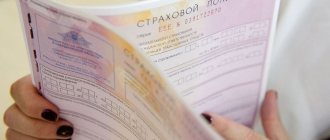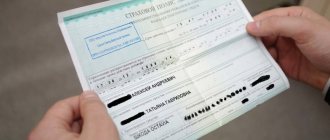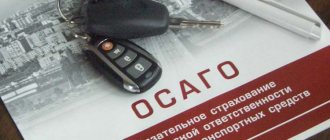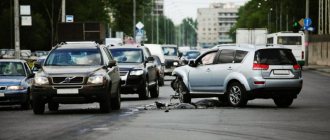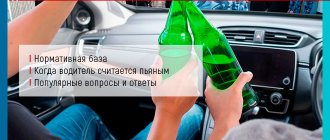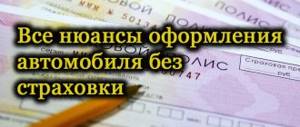Normative base
Analysis of any emergency situation, including one that occurred due to mutual fault, is carried out on the basis of the following regulations:
Attention! If you have any questions, you can chat for free with a lawyer at the bottom of the screen or call Moscow; Saint Petersburg; Free call for all of Russia.
- Provisions of the Civil Code of the Russian Federation (hereinafter referred to as the Civil Code of the Russian Federation);
- Provisions of the Code of the Russian Federation on Administrative Offenses (hereinafter referred to as the Code of Administrative Offenses of the Russian Federation);
- Requirements of the Federal Law of April 25, 2002 N 40-FZ “On compulsory insurance of civil liability of vehicle owners”;
- Articles of the Road Traffic Rules of the Russian Federation, approved by the Decree of the Government of the Russian Federation in the current edition (hereinafter referred to as the SDA);
- Departmental regulations, orders and instructions.
Definition of mutual guilt
Mutual fault in an accident is a largely controversial term and does not have a clear definition that would be enshrined in the Civil or Administrative Codes. However, as practice shows, traffic police officers and insurance companies often use this form of guilt when assessing an emergency situation. So, based on judicial practice, mutual guilt in an accident is a result of an incident in which each participant in one way or another violated traffic rules and is subject to legal liability in accordance with the Code of Administrative Offenses of the Russian Federation.
But, you need to know that, as such, a violation of traffic rules by a road user who is involved in an accident is not a direct basis for admitting mutual guilt. Thus, according to paragraph 2 of the Civil Code of the Russian Federation, compensation for damage occurs in proportion to the degree of guilt of the participants. In other words, if the violation is not related to the actual traffic accident, then the guilt is not recognized as mutual. Eg:
- The accident occurred due to the fact that one of the drivers drove through the intersection at a prohibitory signal. In this case, the second driver did not have the right to drive the vehicle. There is clearly a violation of the rules on the part of both. The first driver will be found guilty of the accident, since it was his violation that was the direct cause of the incident.
- The accident occurred because one driver entered the intersection from a secondary road and stopped to let people pass at the pedestrian crossing. However, the one who was driving along the main road significantly exceeded the speed limit and, approaching the intersection, did not have time to brake and crashed into the first one. In this case, the actions of both drivers may be classified as actions that directly led to the collision.
When is it considered mutual fault in an accident?
Mutual guilt in road traffic accidents occurs in the following cases:
- The event of an accident is a consequence of circumstances in which it is not possible to accurately determine the degree of guilt of the participants. Most often this happens in traffic areas with unregulated conditions, for example, accidents in parking lots, parking lots, etc.
- The result of an accident is a combination of circumstances in which the guilt of the participants is determined exactly, and it is their mutual actions that caused the accident.
- Cases when all parties, when registering an accident, agreed with their mutual guilt.
In any case, the guilt of one or another traffic participant or their mutual guilt is determined by the court, which may not agree with the arguments of the traffic police officers who investigated the incident or the option in which the participants themselves admitted their mutual guilt in the accident.
Degrees of guilt
Even if a traffic accident occurred due to a violation by several traffic participants, the degree of involvement of each of them is determined. In this case, mutual fault in an accident can be:
- Equal.
This degree occurs when all road users contributed equally to the occurrence of the incident, taking into account the following mandatory conditions:
- Violation of traffic rules by each traffic participant.
- The presence of a direct connection between the violation committed by each participant and the incident event.
Consider a classic example: a car driven by a drunk driver crashes into another car driven by a sober driver. Both violated traffic rules, but the accident was caused by a sober driver. This means that the fault will not be recognized as mutual, and the drunk driver will be able to receive compensation for material damage and insurance payments. And only in the future, in accordance with Article 14 of Federal Law No. 40, the insurer, by way of a recourse claim, will demand compensation for the amount of insurance payments from the drunk driver.
- Equal severity of traffic violations committed. In order to determine equal severity, the number of violations of the provisions of the Traffic Rules and the severity of the punishment for them, which is provided for in the Code of Administrative Offences, are taken into account. If they are approximately equal, then the judge makes a decision on equal mutual guilt in the accident if the first two points are present.
- Various.
This degree is determined in cases where one of the participants violated the rules like the second, and both violations caused the accident, but the actions of the first were less gross than the second. When making a decision, the judge relies on the same conditions as when determining equal guilt. The fact is that there is simply no other method, and in some cases, even a highly professional expert will not be able to determine the degree of guilt of a particular driver in an accident.
A striking example of an accident with varying degrees of fault is the case when the driver of a faulty car, stopping on the side of the road, did not put up a warning sign and did not turn on the hazard warning lights. Another driver, moving in the same direction, significantly exceeding the set speed, without noticing a broken down car on the road, drives into it. Wherein:
- Both drivers violated the traffic rules that caused the accident: one did not set the required stop sign and did not turn on the hazard lights, and the second exceeded the speed limit, did not make sure that nothing was obstructing him and failed to avoid the accident.
- The violations of the first driver are less serious. After all, if the other participant in the accident had not exceeded the speed limit, then most likely he would have been able to avoid the collision.
Thus, any court will decide on various mutual faults in an accident.
Procedure for registering an accident
Step-by-step instructions for filing a mutual accident:
- Turn off the engine, put the car on the parking brake, turn on the warning lights and put up a warning triangle.
At night, on the roadway or side of the road, you must wear a jacket or cape vest with elements of reflective material that meet the requirements of GOST 12.4.281-2014. (Traffic rules clause 2.3.4)
- Call the traffic police, you can do this via the hotline.
- Try to find witnesses to the incident on your own, record the damage and the location of the cars with a camera, and if possible, ask other participants about the movement of video recordings.
- Upon arrival of the traffic police officers, tell them as fully as possible about the event and make sure that your words are accurately recorded in the protocol.
- Based on the circumstances of the accident, insist on your innocence.
If there is confidence that the collision was provoked by another participant, then you will have to go to court, where you will need to defend your position.
In case of minor damage to cars and no injuries, it will be possible to draw up a “Euro protocol” without calling the traffic police.
In cases where the traffic police inspector is involved in documenting the result of an accident, it is necessary to unobtrusively monitor his work, especially pay attention to the preparation of the following documents:
- Certificate of traffic accident for each participant.
- A protocol that should reflect:
- car layout;
- distances from reference points;
- description of damage;
- explanations from drivers and eyewitnesses.
- A resolution on the offense indicating a specific article of the Code of Administrative Offenses of the Russian Federation.
Algorithm of actions in case of an accident due to mutual fault of drivers
The procedure and registration of an accident in case of mutual fault of motorists does not differ from the standard one. It is prescribed in paragraphs 2.5-2.6.1 of the traffic rules. Thus, each driver is obliged to:
- stop the vehicle immediately;
- put up a warning triangle and turn on the hazard lights;
- Call the traffic police and an ambulance if there are victims.
Only after this can drivers begin searching for witnesses to the accident and collecting their testimony. You should also take photos and videotape the scene of the incident in such a way that the location of the cars relative to each other and other objects is clearly clear. Then you can call your insurer and report the occurrence of an insured event.
Drivers may not call traffic inspectors if four conditions are met:
- only 2 cars were involved in the accident;
- the accident is not serious and no one was injured;
- there are no disagreements between motorists regarding the circumstances of the accident;
- both drivers have a valid MTPL policy.
In this case, the participants in the accident can draw up a European protocol and disperse. This document can be issued only when the damage limit of 100,000 rubles is not exceeded. In case of larger damage, traffic police will have to be called to the scene.
Damage compensation procedure
To an uninitiated person, it may seem that if an accident occurs due to mutual fault, then the participants in the accident do not pay each other anything, and guilt and repair costs seem to be balanced. However, this is a fundamentally wrong opinion. Paragraph 22 of Article 12 of the Federal Law “On Compulsory Insurance of Civil Liability of Vehicle Owners” states that insurance companies must pay money for damage caused in strict accordance with the degree of guilt of each participant in a traffic accident as determined by the judicial authorities.
If the degree of guilt cannot be determined even in court, then the insurance companies that insure the liability of drivers compensate for property damage in the event of an accident in equal amounts.
Similar requirements are contained in the Civil Code of the Russian Federation, and more specifically in Article 1083, which states that the amount of compensation is reduced in the presence of gross negligence of the victim, which provoked the incident.
Thus, payment of damages in case of an accident with mutual fault is made in the usual manner without providing additional documents and evidence. When assigning payments, the following circumstances are taken into account:
- in order to correctly calculate payments, the degree of culpability of the participants in the accident is taken into account;
- the basis for making payments is a court decision;
- if the judge was unable to determine the degree of guilt of the participants in the incident, then payments are made in equal shares.
Payments under compulsory motor liability insurance in case of mutual fault
In accordance with Article 12 of the so-called law “On Compulsory Motor Liability Insurance”, payments to victims in a road accident are made in proportion to the degree of guilt. And the degree of guilt is calculated in two values:
- Equal.
The most common variant of mutual fault in an accident. It is established either in court or in cases where the investigation of the incident did not reach the court. In such cases, each participant in the accident receives a payment equal to 50% of the damage caused to him.
An example of calculating equal payments is the following case: two cars were damaged in a traffic accident. Repairing the first one will cost 60 thousand rubles, repairing the second one will cost 30 thousand rubles. The court, having considered the circumstances of the accident, recognized the equal mutual guilt of both participants. In this case, the owner of the first car can count on payments in the amount of 30 thousand rubles, the owner of the second – 15 thousand rubles. You will have to find the missing funds yourself.
But there are cases when the damage caused to the car is so great that even the amount that the insurance company will pay to the owner exceeds the amount of insurance payments under normal circumstances. Here you can go to court and demand the necessary money from the participant in the accident. However, this can only be done in the amount of 50% of the total amount.
- Proportional to the guilt.
In cases where the court has determined that all participants are to blame for a road collision, only to varying degrees, then payments of insurance amounts will be proportional to the degree of guilt.
If we consider the previous example and accept that the court determined that the first driver was 10% at fault, and the second 90% at fault, then payments will be made in the following amounts:
- the first driver will receive 54 thousand rubles;
- the second - 3 thousand rubles.
What type of compensation is included in case of mutual fault in an accident?
After 2021, some issues regarding mutual fault in an accident have changed. The innovations began to take effect at the end of April. If both drivers are at fault for the accident, this gives the right to receive a cash equivalent instead of having the car repaired. In this case, one of the main parameters for calculating the amount of payments is the level of wear of the machine.
What to do if a participant in an accident whose car was damaged decides to compensate for his own losses using the classical method? Then you will just need to pay extra, taking into account the degree of guilt. This means that if 30,000 rubles were spent on car repairs, and the owner of the car is only half to blame for the accident, then he will need to pay 15,000 on his own, the remaining difference must be reimbursed by the insurer.
The latter situation is recognized as the most advantageous, because If the payment is made using cash, the driver involved in an accident with mutual fault will also receive 50%.
Here, wear and tear of the car plays an important role, which can reduce the amount of compensation.
Payment under CASCO in case of mutual fault
The specifics of payments to drivers under CASCO insurance are determined by the specific provisions of the insurance contract. If a road traffic accident with mutual fault falls under the terms of insurance and there are no reasons for denial, then the entire insured amount will be paid in full. The insurance company is not interested in whether the victim is at fault.
The grounds for refusal to pay funds must be clearly stated in the contract. If the insurer fails to comply with its obligations, the driver has the right to seek help from the court.
Payments under CASCO insurance
As mentioned above, mutual fault is paid not only under OSAGO, but also under CASCO. Everything is much simpler here - you just need to provide a package of documents confirming that the accident really happened. In this case, no importance is attached to guilt.
If you want to avoid additional costs in the event of an accident with both parties at fault, you can insure yourself voluntarily. For this purpose, there is an extended version of OSAGO (DOSAGO).
Mutual fault in an accident with victims
If in a traffic accident that occurred due to mutual fault there are injuries or even deaths, then, depending on the severity of the harm to health, the drivers responsible for the incident will face administrative or criminal liability.
In accordance with the provisions of the Plenum of the Supreme Court of the Russian Federation No. 25 of June 23, 2015, administrative or criminal liability, including imprisonment, will be borne by both participants in the road accident.
- For harm caused to oneself, you will not have to bear punishment, but the other culprit of the accident will be held accountable depending on the degree of guilt.
- Both drivers responsible for the accident will be responsible for harm caused to an unauthorized participant or passenger in a mutual accident.
Summary
Let's summarize:
- Not every incident in which both drivers violated traffic rules is mutual.
- The relationship cannot be formalized according to the European protocol.
- The presence of guilt on the part of both drivers is not a basis for refusal to pay compulsory motor liability insurance.
- According to the law, the payment to each applicant is 50%.
- If the level of damage is clearly unequal, you can go to court and determine the degree of fault to recover additional compensation.
- If one of the culprits was injured in an accident, the other will be held accountable regardless of the degree of guilt. And if a passenger is injured, then both drivers are held liable.
- If there are no victims or mutual claims, the participants in the incident can simply issue receipts and leave.
More…
- Limit of payments under compulsory motor liability insurance: according to the European protocol, in case of mutual fault, in case of death or harm to health, in case of total damage to the car.
- What does MTPL cover in case of an accident and how much damage does extended insurance cover?
- What happens if you drive someone else’s car without MTPL insurance in the presence of the owner?
- Is the culprit of the accident paid insurance under compulsory motor liability insurance?
Appeal against mutual guilt
For a driver who is found guilty of an accident, adverse consequences occur, expressed in compensation for material damage and execution of punishment. Sometimes, when an accident is recognized as a mutual accident, situations arise when one of the participants considers himself to be unreasonably accused. The optimal way to restore legality for such a driver is to challenge the guilt.
It is worth noting that a participant in a traffic accident is found guilty in the case where there is a stable cause-and-effect relationship between the traffic violation and the accident.
The procedure for appealing against mutual fault in an accident is relevant in the following cases:
- Disagreement of the participant in the accident with the act, which contains conclusions regarding the violation of the rules.
- Lack of a clear cause-and-effect relationship between traffic violations and road accidents.
- Violation of procedural rules and requirements by the person who makes a decision in the case.
The appeal itself can take place in the following order:
- Pre-trial - through a complaint to higher authorities of the traffic police.
- Through the court.
- In civil proceedings.
An appeal against guilt can occur with the aim of assigning mutual guilt in an accident.
Frequently asked questions about mutual guilt
When collecting information regarding mutual guilt, there are often nuances that not everyone knows how to solve. Typically, drivers are looking for answers to the following questions:
Are there cases when a person definitely did not violate traffic rules, but as a result it was he who was guilty?
The traffic rules have an explanation on this matter, which states that the driver must move along the road at a safe speed. It is then that he will be able to control the traffic situation and make the right decisions. When danger arises, there must be sufficient time to stop.
If the driver made the wrong decision regarding the speed of movement, and therefore an accident occurred, this will be regarded as the cause of the accident. In this situation, he will also be found guilty of the incident, and he will bear part of the responsibility for the identified consequences. Moreover, this will happen even if the other party has grossly violated the Rules. In this situation, the driver who became one of the culprits in the accident due to an incorrectly selected speed must prove that he did not have the opportunity to prevent the incident.
Is it possible to prove that the guilt was mutual?
As already mentioned in the article, the main authority that has the right to determine the presence or absence of guilt is the court. Only a judge, having examined all the circumstances surrounding the case, can decide to find the participant in the accident guilty. Until the meeting has passed, each participant in the accident is considered to be at fault. Therefore, if the documentation does not clearly describe the level of guilt of all participants in the accident, then, in their opinion, it is considered the same. In this case, you will definitely need to go to court. At the same time, when submitting an application, you need to remember that it will not be possible to file a claim in order to determine that the second driver is guilty of the accident.
This information is revealed only during the hearing of the case brought against the driver who caused the damage. The defendant must be not only the participant in the accident, but also the company in which the compulsory motor liability insurance was issued.
Behavior at the meeting
There is no doubt that the main component of success in court is the presence of a complete evidence base with which you can confirm your innocence or, conversely, the guilt of the other party. This means that in order to win a case, you need to be active, participate in debates, and refer to certain articles of traffic rules when going through the process.
If you do not have such experience, it is best to hire a qualified lawyer to assist in resolving this issue. Sometimes traceological and technical checks are prescribed. If the work is done correctly, the court will find the culprit and determine to what extent he is guilty. This is the basis for setting the amount of payments.
Who pays for damage in case of mutual fault?
When mutual guilt is recognized, a particularly careful consideration of the case is required. These are the most difficult situations, because you need to determine to what extent the expenses will be repaid. Theoretically, both parties in a given situation will be considered both the injured and injured party at the same time. This means that any of the participants can claim compensation for damage caused by the other party.
If there is insurance, its amount will cover only that part that is directly related to the policyholder. When one of the participants does not have a compulsory motor liability insurance policy, further consideration of the issue regarding the due compensation will take place in court.
Examples of judicial practice
Judicial practice is replete with cases in which road traffic accidents that occurred due to mutual fault are considered.
- In April 2021, the Volzhsky District Court of Samara issued a conclusion in the case of compensation for damage after an accident due to mutual fault. One driver of the vehicle violated the rules for driving through intersections, and the second exceeded the speed limit. The driver who exceeded the speed did not agree with mutual guilt, in which responsibility is imposed in equal shares, and demanded that the blame be distributed in proportions of 10 to 90%. The driver who violated the rules for driving through the intersection, based on expert opinions, was able to prove in court that if the second driver had not exceeded the speed limit, he would have been able to avoid the accident. As a result, the court left the decision on mutual guilt in equal shares unchanged.
- In July 2021, the Sovetsky District Court of Tula issued an opinion on the following case. The accident that occurred in early 2017 involved a driver who failed to give way to a vehicle moving on the main road. The fact that indicated that the car on the main road was moving at a significant speed limit was not taken into account by the traffic police officers. After all the insurance settlements had been made, the victim filed a lawsuit to recover from the culprit the funds needed to repair the car. However, in court, the culprit of the accident presented data that indicated that the victims were speeding, after which the court decided to recognize the accident as a mutual fault and reduce the amount of recovery by half.
Some nuances
- Registration of the European protocol.
The question often arises: is it possible to issue a European protocol if both participants in the accident are at fault? In accordance with Article 12 of the Law “On Compulsory Motor Liability Insurance” and the provisions of the Plenum of the Supreme Court of the Russian Federation No. 25 of June 23, 2015, payments for mutual fault are made in equal shares, unless the court establishes a proportional ratio of fault. In addition, no documents from the traffic police are required to make insurance payments.
Thus, if an accident occurs, you can use the European protocol, but only in cases where both participants admit their own guilt and there are no disputes between them.
- Is it possible to leave the scene of an accident if it is both at fault?
In accordance with the traffic rules of the Russian Federation, it is possible to leave the scene of a traffic accident in cases where a European protocol has been drawn up or when a diagram of the accident has been drawn up and both drivers have gone to the nearest traffic police station for further registration.
In all other cases, leaving the scene of an accident without good reason entails administrative liability, up to and including deprivation of the right to drive a vehicle, regardless of the degree of guilt.
If the insurance company refuses to pay
Unfortunately, the situation when an insurance company refuses to pay when there is mutual fault is not uncommon. Insurers try to avoid transferring compensation until the degree of fault is determined.
In case of an unlawful refusal, try to resolve the conflict with the insurer out of court. As an argument, you can use the position of the Supreme Court of the Russian Federation on this issue.
In accordance with Resolution of the Plenum of the Armed Forces of the Russian Federation of 2015 No. 2, in the presence of mutual guilt:
- the right to payment under compulsory motor liability insurance is retained;
- Insurance companies of road accident participants pay in equal shares.
If this approach seems incorrect to the participant, he has the right to go to court and recover additional payment.
Naturally, it will be recovered from the insurance company only if the claim is satisfied. Penalties are not applied to the insurer in such a situation.

